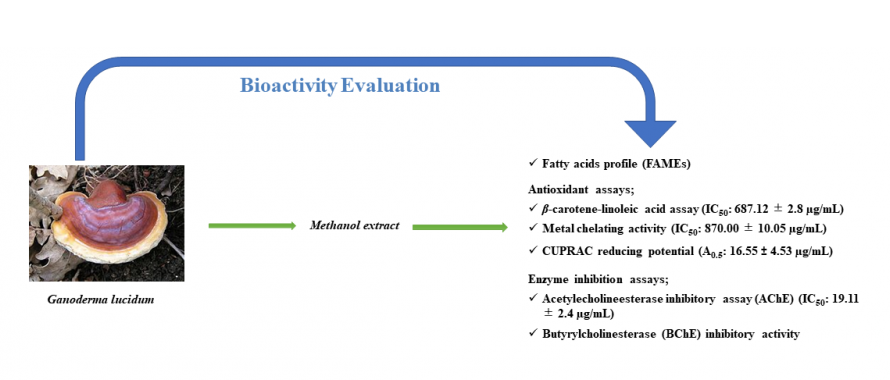JOURNAL 2368
Records of Agricultural and Food Chemistry
Year: 2022 Issue: 1 January-June
p.41 - 49
Viewed 1967 times.
GRAPHICAL ABSTRACT

ABSTRACT
The current study was conducted on methanol extract of Ganoderma lucidum to evaluate its antioxidant, enzyme inhibition activities, and fatty acids profile. The dominant fatty acids were found to be linoleic acid (53.6 %), oleic acid (24.2 %), and palmitic acid (11.5 %) among the 10 different fatty acids detected in the methanol extract using GC/MS techniques. Fatty acids groups like C14:0, C15:0, C16:1, C17:0, C17:1, C18:0, and C18:3 were also found from trace to middle amount (0.15 %, 0.15 %, 1.11 %, 0.26 %, 0.27 %, 2.85 %, and 5.9 %) respectively. Polyunsaturated fatty acids concentration of G. lucidum exposed the significance for lowering the blood cholesterol level. Methanol extract of G. lucidum showed significant antioxidant potential against β-carotene-linoleic acid assay (IC50: 687.12 ± 2.8 µg/mL), metal chelating activity (IC50: 870.00 ± 10.05 µg/mL), and CUPRAC reducing potential (A0.5: 16.55 ± 4.53 µg/mL) respectively. The CUPRAC assay supports the lipid peroxidation inhibitory activity results. Against AChE enzyme, methanol extract of G. lucidum demonstrated IC50 value 19.11 ± 2.4 µg/mL, while exhibited weak butyrylcholinesterase (BChE) inhibitory activity (IC50 > 100 μg/mL). Thus, Ganoderma lucidum may defend people in contradiction of free radical damage, and may be an important source of potential new acetylcholinesterase (AChE) inhibitory drugs.
KEYWORDS- Ganoderma lucidum
- fatty acids profile
- antioxidant
- anticholinesterase inhibitory activity
- medicinal edible mushroom